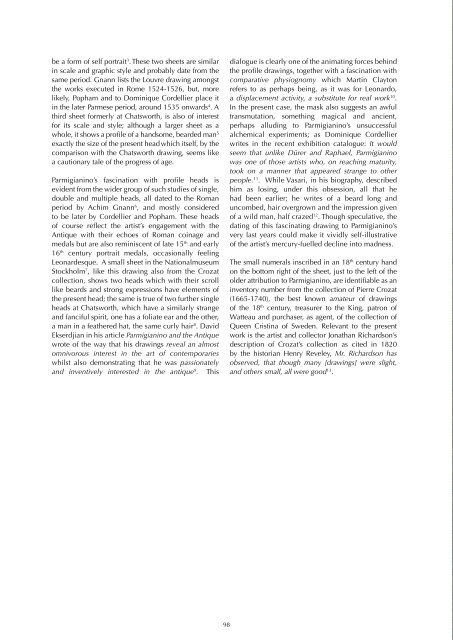Create successful ePaper yourself
Turn your PDF publications into a flip-book with our unique Google optimized e-Paper software.
e a form of self portrait 3 . These two sheets are similar<br />
in scale and graphic style and probably date from the<br />
same period. Gnann lists the Louvre drawing amongst<br />
the works executed in Rome 1524-1526, but, more<br />
likely, Popham and to Dominique Cordellier place it<br />
in the later Parmese period, around 1535 onwards 4 . A<br />
third sheet formerly at Chatsworth, is also of interest<br />
for its scale and style; although a larger sheet as a<br />
whole, it shows a profile of a handsome, bearded man 5<br />
exactly the size of the present head which itself, by the<br />
comparison with the Chatsworth drawing, seems like<br />
a cautionary tale of the progress of age.<br />
Parmigianino’s fascination with profile heads is<br />
evident from the wider group of such studies of single,<br />
double and multiple heads, all dated to the Roman<br />
period by Achim Gnann 6 , and mostly considered<br />
to be later by Cordellier and Popham. These heads<br />
of course reflect the artist’s engagement with the<br />
Antique with their echoes of Roman coinage and<br />
medals but are also reminiscent of late 15 th and early<br />
16 th century portrait medals, occasionally feeling<br />
Leonardesque. A small sheet in the Nationalmuseum<br />
Stockholm 7 , like this drawing also from the Crozat<br />
collection, shows two heads which with their scroll<br />
like beards and strong expressions have elements of<br />
the present head; the same is true of two further single<br />
heads at Chatsworth, which have a similarly strange<br />
and fanciful spirit, one has a foliate ear and the other,<br />
a man in a feathered hat, the same curly hair 8 . David<br />
Ekserdjian in his article Parmigianino and the Antique<br />
wrote of the way that his drawings reveal an almost<br />
omnivorous interest in the art of contemporaries<br />
whilst also demonstrating that he was passionately<br />
and inventively interested in the antique 9 . This<br />
dialogue is clearly one of the animating forces behind<br />
the profile drawings, together with a fascination with<br />
comparative physiognomy which Martin Clayton<br />
refers to as perhaps being, as it was for Leonardo,<br />
a displacement activity, a substitute for real work 10 .<br />
In the present case, the mask also suggests an awful<br />
transmutation, something magical and ancient,<br />
perhaps alluding to Parmigianino’s unsuccessful<br />
alchemical experiments; as Dominique Cordellier<br />
writes in the recent exhibition catalogue: It would<br />
seem that unlike Dürer and Raphael, Parmigianino<br />
was one of those artists who, on reaching maturity,<br />
took on a manner that appeared strange to other<br />
people. 11 . While Vasari, in his biography, described<br />
him as losing, under this obsession, all that he<br />
had been earlier; he writes of a beard long and<br />
uncombed, hair overgrown and the impression given<br />
of a wild man, half crazed 12 . Though speculative, the<br />
dating of this fascinating drawing to Parmigianino’s<br />
very last years could make it vividly self-illustrative<br />
of the artist’s mercury-fuelled decline into madness.<br />
The small numerals inscribed in an 18 th century hand<br />
on the bottom right of the sheet, just to the left of the<br />
older attribution to Parmigianino, are identifiable as an<br />
inventory number from the collection of Pierre Crozat<br />
(1665-1740), the best known amateur of drawings<br />
of the 18 th century, treasurer to the King, patron of<br />
Watteau and purchaser, as agent, of the collection of<br />
Queen Cristina of Sweden. Relevant to the present<br />
work is the artist and collector Jonathan Richardson’s<br />
description of Crozat’s collection as cited in 1820<br />
by the historian Henry Reveley, Mr. Richardson has<br />
observed, that though many [drawings] were slight,<br />
and others small, all were good 13 .<br />
98
















